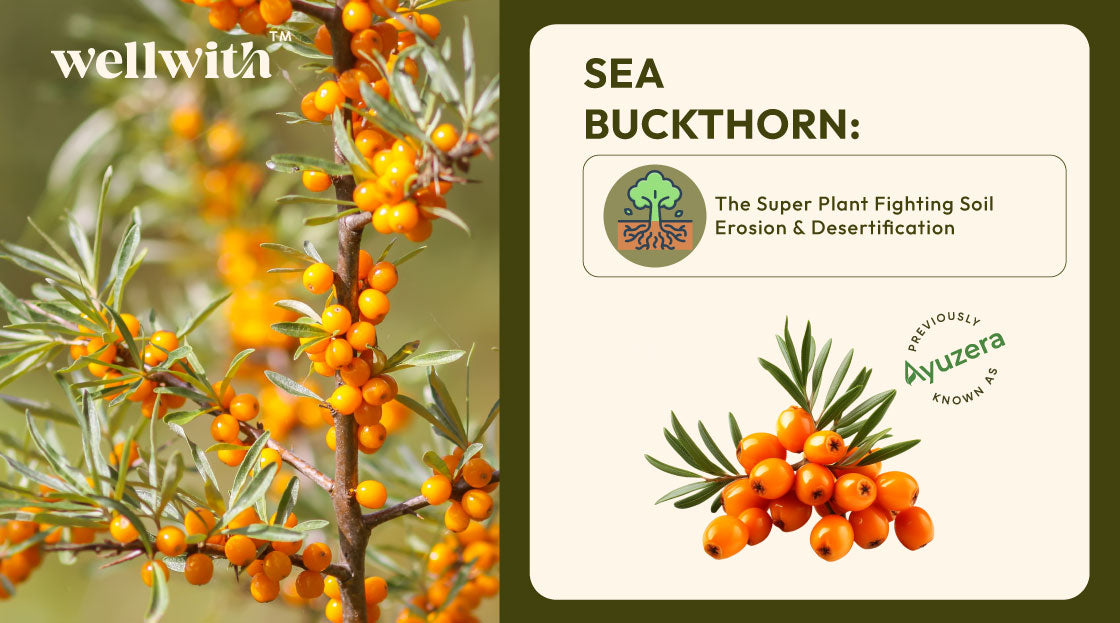Do you think it is really possible to restore greenery and vitality in desertified areas in a short period of time? Well, Sea Buckthorn is a nutritional, deciduous shrub that is gaining recognition for its ecological and commercial value. Its rapid root system helps in combating soil erosion and in enhancing habitat restoration and ecological versatility.
In this article, you will learn about how Sea buckthorn supports biodiversity and contributes to climate change mitigation. Also, you will get to explore the multifaceted role of Sea Buckthorn in ecological restoration, highlighting its benefits, applications, and success stories from regions like China and Mongolia projects.
How Soil Erosion and Desertification Are Problems For Today’s Ecosystem?
Soil erosion and desertification are becoming serious threats to today’s ecosystems by degrading the foundation of terrestrial life and healthy soil. As the erosion strips away nutrient-rich topsoil, it also reduces the fertility of the land and disrupts the growth of plants, whereas desertification transforms the productive landscapes into barren lands.
Thus, these processes result in affecting biodiversity, destabilizing food production, and impairing water retention, which leads to increased flooding and drought. Also, there are some human activities, such as deforestation, overgrazing, and unsustainable farming, that accelerate these changes by weakening the ecosystem's resilience, leading to climate instability.
Role Of Sea Buckthorn In Ecological Restoration
-
Seabuckthorn is a powerful shrub for “sandstorm resistance,” which contributes to ecosystem restoration.
-
With its tenacious vitality, it has become an important part of ecological restoration for desertified areas.
-
It is used as a pioneer plant, which improves the quality of soil with the help of its nitrogen-fixing ability and increases the plant diversity.
-
It is widely used in large-scale ecological restoration projects to help in degrading lands to regain vitality.
-
Sea buckthorn provides a path for the recovery of the entire ecosystem by improving the soil structure.
Top Benefits Of Sea Buckthorn In Combating Soil Erosion And Desertification
Sea Buckthorn plays a vital role in preserving ecological balance for ensuring long-term environmental sustainability. Here are a few benefits that contribute to combating soil erosion and desertification.
1. Soil Improvement
Sea Buckthorn is a combination of physical and biological mechanisms that help improve soil health. Its deep, fibrous root system binds in loose soil by reducing erosion risks. This plant contributes to organic matter through leaf litter and decomposing roots to enrich the soil with nutrients over time.
It is a nitrogen-fixing species, which means it can naturally add nitrogen to the soil by boosting its fertility without synthetic inputs. Thus, its resilience to saline and alkaline conditions ensures rehabilitation of degraded lands by paving the way for the return of diverse vegetation to support long-term ecological restoration.
2. Soil Stabilization
The extensive root system of Seabuckthorn binds the soil tightly by reducing surface runoff and preventing the loss of nutrient-rich topsoil. It thrives in degraded, arid, and high-altitude regions, making it ideal for reclaiming barren landscapes.
With its nitrogen fixation and organic matter enrichment, it improves the fertility of the soil. Thus, its resilience to drought, wind, and poor soil conditions promotes long-term ecological restoration and works as a natural barrier against desertification and land degradation.
3. Increased Biodiversity
To create a supportive microhabitat in degraded and arid regions, Seabuckthorn contributes to increased biodiversity. Its dense foliage and thorny branches offer shelter and nesting sites for birds and small mammals, while its nutrient-rich berries serve as a food source for various wildlife species.
The Seabuckthorn plant effectively attracts pollinators by supporting diverse plant growth and acts as a keystone species in restoring ecological networks and enhancing habitat complexity. Thus, it encourages the growth of diverse flora by enabling the re-establishment of native plants and animal communities to foster a more balanced and resilient ecosystem.
4. Climate Change Mitigation
The powerful ecological functions and adaptability to harsh environments of Seabuckthorn help in mitigating climate change. Its deep root system stabilizes the soil and reduces the risk of erosion. This helps in maintaining carbon-rich topsoil to enhance carbon sequestration by absorbing atmospheric CO₂ for storing it in biomass and soil.
Its ability to thrive in degraded, arid, and high-altitude regions makes it crucial for restoring the land's fertility and supporting reforestation efforts. Thus, the Sea buckthorn shrub contributes to the sustainability of livelihoods and greenery by aligning with climate goals like India’s Bonn Challenge targets.
How Sea Buckthorn Is Being Used For Ecological Balance?
- Afforestation and Reforestation: To restore degraded land and promote the ecosystem, the sea buckthorn plant is being used in afforestation and reforestation efforts.
- Soil Conservation: Due to its deep-rooted system and ability to thrive in harsh, degraded terrains, a sea buckthorn is used as a natural bio-engineering solution to prevent soil erosion.
- Sustainable Agriculture: Sea buckthorn is effectively used for sustainable agriculture practices to improve soil fertility and support plant growth.
Sea Buckthorn To Combat Soil Erosion and Desertification- Success Stories
1. China's Loess Plateau
In China’s Loess Plateau, Seabuckthorn has played a transformative role in restoring the soil structure with its deep roots that reduce erosion. It enhances the soil fertility, therefore the local communities are benefiting economically by harvesting its berries for health products and cultivating seedlings. Hence, this dual impact of Sea Buckthorn has made it a cornerstone of sustainable land management and rural development in this region.
2. Mongolia's Desertification Control Project
In Mongolia’s Desertification Control Project, the plants of Seabuckthorn have been successfully planted along the banks of the Onggi River to stabilize sand dunes and land degradation. Therefore, the native people of Mongolia have been trained to cultivate and take care of the plants to create a sustainable livelihood. Hence, they harvest for juice, oil, and cosmetics to add economic value to the region. This initiative has helped restore ecological balance while empowering communities affected by desertification.
Wrap Up
In this article, we came to know that the Sea buckthorn plant stands out as a powerful substitute to fight against land degradation and desertification. Its adaptability to harsh climates makes it ideal for restoring ecological balance in vulnerable regions. Whether you want to improve the soil health or want to stabilize the terrain to foster biodiversity and support sustainable livelihoods, Sea Buckthorn offers a holistic approach to environmental recovery.
However, as the global efforts intensify to combat climate change and restore degraded lands, integrating Sea buckthorn into large-scale restoration projects results in a promising path towards a greener and balanced ecosystem.
FAQs:
Why does sea buckthorn work so well to prevent soil erosion?
Particularly on slopes and degraded lands, Seabuckthorn's deep, fibrous root system binds loose soil to minimize the runoff and stop topsoil loss.
In what ways does sea buckthorn aid in the fight against desertification?
Through nitrogen fixation and the accumulation of organic matter, seabuckthorn flourishes in arid, nutrient-poor soils to increase soil fertility and restore vegetation cover.
Does biodiversity benefit from sea buckthorn?
Yes, it helps restore ecological networks by giving birds, mammals, and pollinators a place to live and food.
Can sea buckthorn help in climate change mitigation?
Yes, sea buckthorn promotes reforestation in high-altitude and degraded areas, stabilizes carbon-rich soil, and stores CO₂ in biomass.
Is sea buckthorn good for the economy?
Yes, sea buckthorn berries are high in vitamins and antioxidants and are used to make juices, cosmetics, and health products that help local communities generate income.




